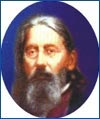Warm sweat from epilepsy.
Profuse sweat. Typhus.
Sweats periodically : 11 P.M., or 3 to 5 P.M.
Night-sweats : sour or offensive; debilitating; mostly after midnight.
Typhoid forms of fever, great debility, profuse sweat; desire to be magnetized.
Spotted fever; also in slow convalescence.
Attacks
New moon : Increase of moon : Full moon; Every two or three months : Every seventh day : Every evening : Periodically :.
Sides
Right :,,, Left : Below upward : Above downward : Front to back;, Within outward :.
Sensations
Feels as if she was divided into halves and that the left side did not belong to her.
Susceptible to nervous stimuli, to magnetism; exhaustion from suppuration.
Wandering pains; sudden pains passing quickly over body.
Prickling tingling in various parts.
Tissues
Fungi easily bleeding.
Discharges and excretions offensive : pus, stools, sweat of feet, etc.
Hemorrhages : from nose, stomach, bowels, or lungs. Swelling inflammation, also, suppuration of glands.
Inflammation, swelling, ulceration and necrosis of bones.
Dropsy. Emaciation. Rachitis.
Fibrous parts of joints, especially of the knee, inflamed.
Children, while growing, suffer with violent pains, swelling of limbs and congestion.
Cellular inflammation; boils, abscesses, etc., stage of suppuration; tardy recovery; subsequent induration.
Malignant and gangrenous inflammations.
Cancer.
Fistulous openings, discharge offensive; parts around hard, swollen, bluish-red :.
Contact Injuries etc.
Touch :, Jarring : Pressure;,, Scratching :. Riding; After a fall, periostitis; spine disease; ulcers near spine.
Erysipelas of scalp after injury to bones.
Ailments from vaccination.
Small foreign bodies under skin; promotes expulsions.
Must hold on to something for relief of palpitation :.
Skin
Skin wax-like. Tuberculosis. Caries.
Yellow, earthy skin; sometimes covered with pityriasis.
Itching exanthema; small pustules filled with lymph, dying quickly.
Eruption burns only by day. Acne.
Small wounds suppurate profusely.
Eczematous, impetiginous, or herpetic eruptions.
Rhagades around eyelids, lips, etc.
Rose-colored blotches.
Small blisters.
Pemphigus.
Zona.
Erysipelas, with suppuration; deep-seated, phlegmonous erysipelas.
Boils come in crops; tendency to boils; leave indurations.
Abscesses speedily “point,” but secretion of pus is too scanty.
Malignant pustule.
Ulcers; from suppuration of membranous parts; phagedenic; extend in depth; after abuse of mercury; offensive, with ichor, proud flesh, stinging, burning, itching; edges hard, high or spongy.
Carbuncles; Large fleshy warts suppurating.
Variola; suppuration exhausts the patients, and desiccation delays; bone diseases as sequelae.
Stages and States
Especially suitable for children, large heads, open sutures; much sweat about head : large bellies.
Nervous, irritable persons, with dry skin, profuse saliva, diarrhoea, night-sweats.
Weakly persons, fine skin, pale face; light complexion; lax muscles.
Hereditary rheumatism.
Scrofulous diathesis. Rachitic, anaemic conditions; caries.
Oversensitive, imperfectly nourished, not from want of food but from imperfect assimilation.
Stone-cutters; chest affections and total loss of strength.
Relationship
Silicea is frequently indicated after; Bellad., Bryon., Calcarea ostr., Cina, Graphit., Hepar, Ignat., Nitr. ac., Phosphor.
After Silicea; Fluor. ac, which also antidotes its abuse; Hepar, if pimples appear around the ulcer.
Laches., Lycop., Sepia, also follow well.
Silicea antidotes; the abuse of mercury, but does not follow the potentized Mercur. well; Sulphur.
Antidotes to Silicea : Acidum fluoricum, Hepar.
Complementary to Thuja.
Compare Gettysburg water (soreness between vertebrae worse on motion, pus from joints, as in caries of vertebrae, hip-joint disease, etc.).

